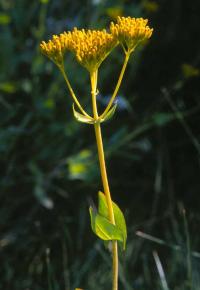Annuals, perennials, or subshrubs, to 200+ cm [trees to 400 cm] (usually ± succulent, herbage usually glaucous). Stems (often purplish) erect or decumbent, branched distally or ± throughout. Leaves cauline; opposite (decussate); petiolate or sessile (weakly connate to connate-perfoliate); blades (often 3-nerved) oblong-ovate to lanceolate or linear, margins entire, serrate, or spinulose-serrate, faces glabrous or short-pubescent. Heads radiate or discoid, usually in tight or loose aggregations in (often flat-topped) ± corymbiform arrays or glomerules. Involucres oblong, urceolate, cylindric, or turbinate, 0.5-2 mm diam. Phyllaries persistent, 2-6(-9) in ± 1 series (linear, concave, or boat-shaped, subequal). Receptacles convex, epaleate ('receptacles' of glomerules sometimes setose). Ray florets 0-1(-2), pistillate, fertile; corollas yellow or whitish (laminae inconspicuous). Disc florets 1-15, bisexual, fertile; corollas yellow, tubes shorter than to about equaling funnelform to campanulate throats, lobes 5, ± deltate. Cypselae (black) weakly compressed, narrowly oblanceolate or linear-oblong (usually 10-nerved, glabrous); pappi usually 0, sometimes persistent, of 2-4 hyaline scales, or coroniform (of connate scales). x = 18.
Members of Flaveria are frequently found in alkaline, saline, and gypseous soils, often in disturbed and moist areas. Heads of Flaveria may be either radiate or discoid; when both are present in the same capitulescence, the discoid heads tend to be central and the radiate heads peripheral. Many species of Flaveria have persistent sheathing leaf bases that ring the stems after the leaves have fallen.
Flaveria is notable because certain species exhibit C3 photosynthesis, some C3-C4 (intermediate) photosynthesis, and others (F. brownii, F. bidentis, F. campestris, and F. trinervia in the United States) classic C4 photosynthesis.
Rays pistillate and fertile, yellow, inconspicuous, commonly solitary, or sometimes wanting; invol of 2-8 subequal greenish bracts, occasionally with 1 or 2 smaller outer ones; receptacle small, naked or sometimes bristly; disk-fls 1-15, perfect and fertile, yellow; style-branches flattened, truncate, minutely penicillate; achenes glabrous, ca 10-ribbed; pappus wanting, or of 2-4 irregular scales; herbs with narrow, opposite, sessile and often connate lvs, and numerous small, sessile or subsessile glomerate heads. 20, New World.
Gleason, Henry A. & Cronquist, Arthur J. 1991. Manual of vascular plants of northeastern United States and adjacent Canada. lxxv + 910 pp.
©The New York Botanical Garden. All rights reserved. Used by permission.






